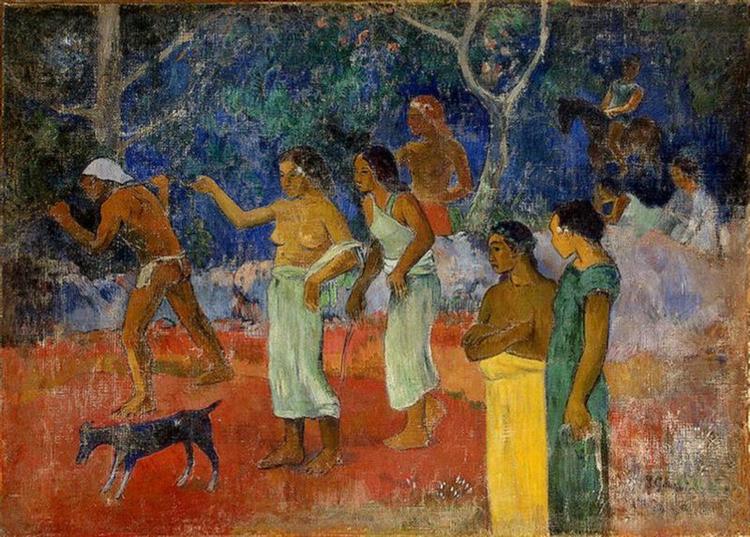תיאור
Paul Gauguin's "Scene of Tahitian Life" (1896) is a vibrant testament to the artist's interest in capturing the everyday life and culture of Polynesia, which he fell in love with during his years living in Tahiti. A provocateur and innovator of Post-Impressionism, Gauguin achieved a unique form of artistic expression by integrating his own style with influences from local culture, creating works that are both a reflection of his own spiritual quest and a window into a world he perceived as pure and authentic.
The composition of this painting is structured around the depiction of an everyday scene, in which several female figures are grouped together in a tropical landscape. These women, with brown-toned skin and dressed in sarongs, are immersed in the activities of daily life, thus symbolizing the simplicity and tranquility of Tahitian existence. One of the women appears to be in the act of harvesting, which can be interpreted as a connection with the land and nature. The relaxed posture and serene expression of these figures suggest a harmony with their surroundings, an idea that Gauguin sought to communicate in opposition to the Western life that he considered fast-paced and superficial.
The use of color in “Scene of Tahitian Life” is remarkable. The vibrant hues and intense contrasts characteristic of Gauguin’s work create an almost dreamlike atmosphere. The background plays with a range of greens and blues that evoke the island’s lush vegetation. The red and yellow in the women’s sarongs bring a luminosity that highlights the cultural richness of Tahiti. This use of color, not only to represent reality but to convey moods and sensations, is one of the hallmarks of Gauguin’s technique. His desire to evoke emotions through color translates into a visual experience that flirts with the symbolic rather than the merely representational.
On a thematic level, the work reflects Gauguin's romantic vision of life in Polynesia. Escaping European modernity, he sought an art form that could be a vehicle for his spiritual and aesthetic longings. The female figure, which appears in multiple works throughout his career, is a symbol of the connection between the earthly and the spiritual in his pictorial narrative. In "Scene of Tahitian Life," the women represent not only Tahitian culture, but also an ideal of beauty and simplicity that aligns with the ideas of Japan and primitive culture that so fascinated the artists of his time.
Gauguin had been a pioneer in the exploration of the exotic, and his work often focuses on subjective interpretation rather than faithful representation. This work is not a mere transcription of life in Tahiti, but a synthesis of the artist's personal experience, his desire to find authenticity and connection in a world that he felt increasingly estranged from his roots. "Scene of Tahitian Life" stands as a bridge between his own need for spiritual rebirth and the vibrant culture he encountered on his journey.
The impact of this work and Gauguin's career are enormous, as they opened the doors to a new world of possibilities in the representation of art. His approach has influenced generations of artists, and "Scene of Tahitian Life" remains a clear example of how painting can transcend mere imagery to become a vehicle for ideas, emotions and a commentary on life itself. In every stroke and in every color, a world of introspection can be glimpsed, reflecting the restless spirit of a man who dedicated his life to exploring the distance between beauty and truth.
KUADROS ©, a famous painting on your wall.
Hand-made oil painting reproductions, with the quality of professional artists and the distinctive seal of KUADROS ©.
Painting reproduction service with satisfaction guarantee. If you are not completely satisfied with the replica of your painting, we will refund 100% of your money.

